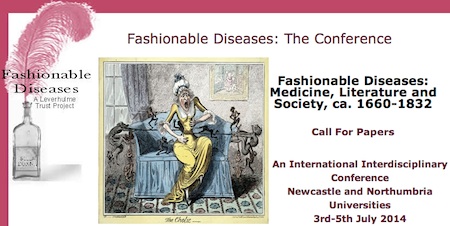Fashionable scholars will flock to The Fashionable Diseases Conference this coming July 3-5, hosted jointly by Newcastle and Northumbria Universities, sponsored by the often-fashionable Leverhulme Trust.
The most fashionable diseases, for purposes of the gathering, are the ones suffered, diagnosed, discussed, and flaunted between the years 1660 and 1832. That timespan, evidently, saw the height of fashion in fashionable diseases, especially in England.
The organizers, who are good with words, say this about that:
In the eighteenth century, as well as our own, certain diseases could be construed as endowing a sick person with some social or cultural cachet popularly associated with the illness. Melancholy could lend an air of creativity, gout could indicate class and wealth, and nerves could suggest a fashionable sensibility. A slight illness and enough wealth to travel could lead one to the spas and seaside resorts that, outside of London, formed the centres of fashionable society, or perhaps even lead abroad for warmer climes. As such, fashionable diseases also became the object of stigma, satire and allegations of fakery. They could be linked to the putative artificiality of ‘manners,’ modishness and the posturing of the beau monde…. This project interrogates the meanings of the word ‘fashionable’ when applied to disease, and particularly explores the ways in which the medicine, literature and culture of the eighteenth century define and represent often debilitating diseases as fashionable.
(Thanks to investigator Ivan Oransky for bringing this to our attention.)
BONUS (a philosophical observation of no importance): It may be safer to talk about fashionable diseases of the past then of fashionable diseases of the present. To speak of the latter risks anger and visitations from some of the more fervent diagnosed, diagnosers, and dispensers of nostrums, incantations, implements, and billable services.
